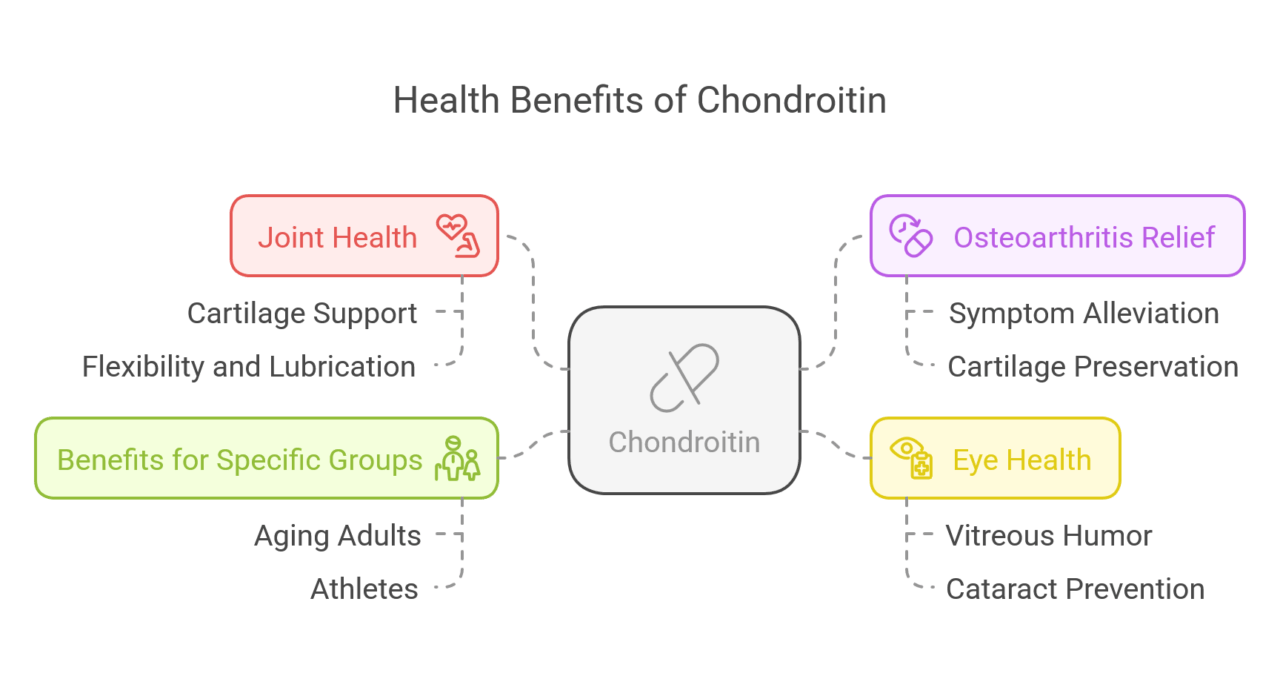
Introduction
To live an active lifestyle, it’s important to keep your joints healthy. Chondroitin sulfate is a natural compound found in cartilage. People are paying more attention to it because it may help support joint health. Many people are now using chondroitin supplements to fight joint pain and swelling. Let’s take a closer look at the science behind this popular supplement and what it might mean for active individuals.
What is Chondroitin?
Chondroitin sulfate, often just called sodium chondroitin, is a natural chemical found in the cartilage of both humans and animals. It belongs to a group called glycosaminoglycans (GAGs). These substances are important for building and keeping cartilage healthy in the form of chondroitin sulfate. Cartilage is the soft tissue that cushions our joints. Chondroitin sulfate helps this tissue stay strong and absorb shock.
As a dietary supplement, chondroitin sulfate usually comes from animal sources, like shark and cow cartilage. You can find it in different forms, such as capsules, tablets, and powders.
People take chondroitin supplements because they believe it can slow down cartilage loss and even help repair it. As we age and our joints experience wear and tear, cartilage can break down, causing pain, stiffness, and less movement. Chondroitin supplements aim to help by giving our bodies more of this important compound.
Key Roles of Chondroitin in the Body
Chondroitin mainly helps with joint health. This amazing compound works by pulling water molecules into the cartilage. This keeps joints well-lubricated and able to absorb shock. You can think of it like a sponge, keeping joints hydrated and comfortable. This allows for easy and painless movement.
Chondroitin may also stop some enzymes that break down cartilage. This helps keep our joints healthy and lasting longer. By possibly slowing down this breakdown, chondroitin can help prevent or delay joint diseases like osteoarthritis.
Although many people use chondroitin supplements, scientific proof of its effectiveness is mixed. Some studies show it can help with joint pain and move better, while others find fewer solid results. Still, since it is found naturally in cartilage and has potential benefits, it’s a supplement that should be looked into more.
Common Forms of Chondroitin
Chondroitin sulfate is easy to find as a dietary supplement. It comes in different forms to match personal choices. Here are some common forms:
- Capsules: Chondroitin sulfate capsules are a popular pick. They are easy to take and swallow. These capsules usually have chondroitin sulfate powder inside a gelatin or vegetarian shell.
- Tablets: Tablets are another solid option for chondroitin sulfate. They are handy like capsules and may be coated to hide any bad aftertaste.
- Powders: If you’re looking for flexibility, chondroitin sulfate powder is a great choice. You can mix this powder easily with drinks or food.
It’s important to choose the right form of chondroitin supplements based on what you like and your lifestyle. Capsules and tablets are convenient, while powders let you adjust doses and mix with meals or drinks more easily.
Chondroitin Dosage Guidelines
Choosing the right amount of chondroitin to take depends on a few things. These include your age, health, and how serious your joint problems are. It is important to talk to a healthcare professional before starting any new supplement.
A common amount for chondroitin is between 800 to 1200 mg each day. This should be split into two or three doses. These guidelines are based on the amounts often used in clinical trials, such as the chondroitin arthritis intervention trial, that study the benefits of chondroitin for osteoarthritis and other joint-related issues.
Keep in mind that chondroitin guidelines may not work for everyone, especially those looking for effective weight loss solutions. How people respond to supplements can be different. Some may feel better using less or more than what is generally suggested.
Health Benefits of Chondroitin

Chondroitin has been studied a lot for its possible health benefits. It may help with joint health and reduce symptoms linked to osteoarthritis.
Researchers are still looking into all its benefits. Chondroitin appears to be a good supplement for people who want to support their cartilage health.
Osteoarthritis Symptom Relief
Osteoarthritis is a common joint problem that leads to the breakdown of cartilage, especially in the knees. It can cause severe pain, stiffness, and make it hard to move. Chondroitin sulfate has come up as a possible treatment to help with the symptoms of osteoarthritis and degenerative joint disease, warranting further investigation through a systematic review.
Research on knee osteoarthritis has looked at how well chondroitin sulfate works for reducing osteoarthritis pain and improving the effectiveness of chondroitin in how the joints function. It is believed to help slow down the loss of cartilage, promote the creation of new cartilage, and lessen swelling in the joint.
Even though individual results can differ, using chondroitin sulfate along with other treatments and lifestyle changes might help ease symptoms and support overall joint health.
Joint Health and Flexibility
Keeping your joints healthy and flexible is very important for your movement and quality of life. Chondroitin helps with joint health in many ways, not just for easing osteoarthritis symptoms. It supports the cartilage, which helps keep joints flexible, well-lubricated, and able to move freely.
Chondroitin can attract and hold water in cartilage. This helps it cushion the joints and allows for smooth movement. It also stops friction between bones. Good lubrication is very important. It helps prevent joint stiffness and keeps our flexibility as we get older or do hard physical activities.
Taking chondroitin regularly, whether from natural foods or supplements, can help you keep your joint health.
Eye Health and Cataract Prevention
Chondroitin has benefits beyond just joint health. New research shows it might help keep eyes healthy and even prevent cataracts.
Chondroitin sulfate is an important part of the vitreous humor, which is the gel-like substance in the eye. It helps keep the eye’s structure strong and clear. This is important for light to pass through correctly.
More research is needed to confirm the link between chondroitin and preventing cataracts. However, because it’s found in the eye and helps maintain eye health, it is a good topic for future studies.
Benefits for Aging Adults and Athletes
Maintaining good joint health is important for everyone. However, it is especially vital for two key groups: older adults and athletes.
As we get older, our bodies naturally produce less chondroitin. This can lead to joint stiffness, less mobility, and a greater chance of osteoarthritis. Taking chondroitin as a supplement can help boost these lower levels and support joint health as we age.
For athletes, their joints often endure repeated stress and impact. This can speed up the wear on cartilage, causing joint pain and injuries. Since chondroitin may support cartilage health and lessen inflammation, it can be a useful supplement. Athletes can benefit from it to recover faster, avoid injuries, and keep performing at their best.
Natural Sources of Chondroitin

Chondroitin is mostly seen as a dietary supplement. But you should know that it is also present in some foods. Getting enough chondroitin from food alone can be difficult.
Still, adding these foods to your diet might provide extra nutritional benefits. This can help support your joint health along with other methods.
Chondroitin in Food Sources
Including natural sources of chondroitin in your diet can help support your joints. However, it is hard to get enough chondroitin just from food.
Animal cartilage is the main natural source of chondroitin. This means that meat with cartilage, like drumsticks from chicken, beef shank, and pork ribs, can offer a small amount of this helpful compound. Bone broth is also becoming popular. It is made by cooking bones and connective tissues, which may give some chondroitin.
Even though the amounts in these natural foods may be lower than in supplements, adding them to your meals can still help with joint health and your overall wellness.
Natural Sources vs. Supplements
When you think about chondroitin intake, both natural sources and supplements play a role in joint health. The choice between them depends on what you need and your goals.
Natural sources like bone-in meats and bone broth can be helpful. However, the chondroitin you get from these food options might not be enough for treatment. If you want a stronger dose, especially for managing osteoarthritis symptoms, chondroitin supplements may be a better option.
In the end, talking to a healthcare professional about your needs can help you find the best way to add chondroitin to your routine.
| Feature | Natural Food Sources | Chondroitin Supplements |
|---|---|---|
| Examples | Bone broth, beef cartilage, chicken drumsticks, pork ribs | Capsules, tablets, powders, softgels |
| Chondroitin Content | Low and variable | Standardized and concentrated (typically 400–1200 mg per serving) |
| Bioavailability | Moderate | High, especially when combined with glucosamine or MSM |
| Convenience | Requires cooking/preparation | Easy to use, portable, no prep needed |
| Other Nutrients Present | Collagen, amino acids, minerals | May include synergistic nutrients in stacked formulas |
| Best For | Complementing a joint-health-focused diet | Therapeutic use, consistent dosage for osteoarthritis relief |
Practical Usage Guidelines

Add chondroitin supplements to your daily routine carefully. This can help you get the most benefits.
This part gives you useful tips on how much to take, when to take it, and how long it may take to see results.
Recommended Dosage Based on Goals
The recommended dose of chondroitin can change based on your health needs and goals. It’s best to talk to a healthcare professional. They can help you find the right dosage for you.
For general joint health, taking a lower dose of chondroitin, like 400-800 mg every day, may be good for maintaining joint space width. This can help with cartilage health, joint lubrication, and might reduce joint stiffness that comes with age.
If you want to manage osteoarthritis symptoms or have serious joint issues, a higher dose of chondroitin, usually 800-1200 mg each day, may be needed.
Keep in mind that chondroitin dosage is different for everyone. Your personal factors matter. By working with your healthcare provider, you can ensure it’s safe and works well for you.
When and How to Take Chondroitin
Knowing when and how to take chondroitin sulfate can help your body absorb it better and make it more effective.
For oral administration of chondroitin sulfate in capsules, tablets, or powder, taking it with food can help reduce stomach upset. Eating may help your body take in this supplement and lower the chances of any stomach issues.
The timing may change based on the type of supplement and personal needs, but being consistent is important. Making a regular plan for taking chondroitin can keep levels steady in your body and may help it work even better.
How Long to Take Chondroitin and When to Expect Results
The time you need to take chondroitin and when you can see results can be different for each person and their specific joint problems.
Chondroitin doesn’t work like some pain medicines that act fast. It helps the cartilage over time. You should think of it as a long-term plan for your joints, not just a quick solution.
Some people may feel small changes in joint comfort and movement in a few weeks. However, it usually takes about 2-3 months of regular use to see real results. It’s important to be patient and stick to the recommended dosage during this time.
Chondroitin in Active Lifestyles
Chondroitin is really important for people who live active lives. It helps keep joints healthy and supports fitness goals.
If you are an athlete who wants to perform your best, or if you are getting older and want to stay active, using chondroitin can be a great idea.
Athletes and Fitness Recovery
Athletes often push their bodies hard. This can really stress their joints. Over time, this wear and tear can harm joint health, making recovery longer and hurting performance. Many athletes now choose chondroitin as a supplement to help their joints and improve recovery.
Chondroitin might reduce inflammation, especially when studies show a low risk of bias. This can help lessen joint pain and discomfort from tough workouts. It also supports cartilage and keeps joints lubricated. This can lead to better flexibility and movement, helping athletes perform at their best and reduce the chance of injury.
While everyone may react differently, chondroitin can offer useful benefits for athletes. It is a supplement that is worth thinking about.
Aging Population Joint Maintenance
As we get older, taking care of our joints becomes very important, especially for those with rheumatoid arthritis. This helps us stay active and keep a good quality of life. Many older people have issues like joint pain and stiffness, which usually happen because their cartilage is wearing down. The use of chondroitin has become popular as a way to help with joint health in older adults.
With age, our bodies make less chondroitin. This can hurt cartilage health and make us more likely to have joint problems. Taking chondroitin as a supplement might help by giving our bodies more of this important substance.
Chondroitin could be important for keeping joint health by supporting cartilage, reducing inflammation, and helping with joint lubrication.
Chondroitin and Supplement Stacking

The trend of using several supplements together is called “stacking.” It is becoming more popular. Chondroitin is a supplement that is often taken with others to improve the quality of the results for joint health.
Now, let’s look at some smart combinations that include chondroitin and see their possible benefits.
Combining with Glucosamine
Chondroitin and glucosamine are often found together in one supplement because they are thought to work well together. Glucosamine sulfate is a natural substance found in cartilage, just like chondroitin, and it helps keep cartilage healthy.
When used together, these two compounds are believed to help with different parts of joint health. Chondroitin mainly helps with lubrication and keeping water in the cartilage. Glucosamine helps repair cartilage and makes hyaluronic acid, which is important for synovial fluid that keeps joints lubricated.
This helpful relationship is why many people take chondroitin-glucosamine supplements, especially for easing osteoarthritis of the knee symptoms and seeking pain relief. While the scientific proof of how well they work together is mixed, many people say they get relief from joint pain and find it easier to move with this combination.
| Feature | Chondroitin | Glucosamine |
|---|---|---|
| Primary Function | Maintains cartilage hydration and elasticity | Helps build and repair cartilage |
| Source | Typically from animal cartilage (shark, bovine, porcine) | Derived from shellfish shells or made synthetically |
| Mechanism of Action | Attracts water to cartilage, inhibits breakdown enzymes | Stimulates production of proteoglycans and hyaluronic acid |
| Common Form | Capsules, tablets, powders | Capsules, tablets, powders |
| Use in Supplements | Often combined with glucosamine and MSM | Often combined with chondroitin and MSM |
| Best For | Improving joint lubrication and cushioning | Supporting cartilage structure and slowing its degradation |
| Onset of Action | May take 2–3 months for noticeable effects | Similar onset, typically within 2–3 months |
| Clinical Evidence | Mixed results, some studies show benefit for osteoarthritis | Similar—some positive effects in joint pain reduction and function improvement |
| Vegan/Vegetarian Options | Limited (mostly animal-derived, some fermented sources available) | Shellfish-free versions available, but fewer options overall |
| Commonly Used For | Osteoarthritis, joint stiffness, cartilage wear | Osteoarthritis, joint repair, inflammation |
Best Synergistic Nutrients (MSM, Collagen, Omega-3)
Chondroitin sulfate works well when combined with other helpful nutrients. These include MSM, collagen, and omega-3. When used together, they can improve how chondroitin helps in the management of knee joint pain and knee osteoarthritis. Research shows that this combination can boost joint health. It may reduce inflammation and support cartilage structure. Adding these nutrients to your daily routine may give good support for active lifestyles.
| Nutrient | Function | Benefits When Combined with Chondroitin |
|---|---|---|
| Glucosamine | Supports cartilage repair and synovial fluid production | Enhances joint cushioning, improves cartilage regeneration |
| MSM (Methylsulfonylmethane) | Provides sulfur for connective tissue; reduces inflammation | Boosts anti-inflammatory effects, supports pain relief |
| Collagen | Builds cartilage and connective tissue | Improves cartilage structure and resilience, complements chondroitin’s hydration |
| Omega-3 Fatty Acids | Reduces joint inflammation and stiffness | Enhances anti-inflammatory action, may increase absorption of chondroitin |
| Hyaluronic Acid | Lubricates joints and retains moisture | Works synergistically to enhance joint fluid viscosity and cushioning |
| Vitamin C | Supports collagen synthesis and acts as an antioxidant | Enhances collagen absorption, protects joint tissues from oxidative damage |
Interactions and Medical Considerations
Chondroitin is usually safe for most adults. However, it is important to know about possible interactions and health issues before adding it to your routine. Knowing these things helps you use it safely and effectively.
Drug Interactions
Before you start using chondroitin supplements, you should know about possible drug interactions. This is especially important if you take other medications.
A key interaction is with blood thinners. Chondroitin might thin the blood a little. Using it with anticoagulants or antiplatelet drugs can raise the chance of bleeding. If you take blood thinners, you must talk to your doctor before using chondroitin.
Also, chondroitin is usually safe when taken as advised, but you should be careful if you have any health issues.
Who Should Avoid It
Chondroitin is usually safe for most people, but some should be careful or stay away from it. This is because there may be risks or not enough research on it.
People at high risk of bleeding or those using blood thinners should talk to their doctor before taking chondroitin, which has a high risk of bias due to its potential effects. It may have light blood-thinning effects. Taking it with blood thinners could raise the risk of bleeding.
Pregnant or breastfeeding women should also be careful. They should avoid chondroitin because its safety hasn’t been shown during pregnancy and while nursing.
It’s important to talk with your healthcare provider about your health history and any other medications before starting chondroitin or any new supplements.
Precautions for Special Groups (e.g., pregnancy, surgery)
It is very important for people in special situations, like pregnant women or those having surgery, to be careful when thinking about chondroitin supplements. Pregnant women should talk to their doctor before starting any new dietary supplement, including chondroitin, to make sure it’s safe. Also, people who are going to have surgery should tell their healthcare team if they are taking chondroitin, as it might interact with some medications or impact the surgical process. Paying attention to these precautions can help keep these groups healthy.
Side Effects and What to Watch For
Chondroitin is usually safe for most adults when used as recommended. However, just like other supplements, it may cause some mild side effects. Most of these effects are related to the stomach and are usually temporary.
The common side effects of chondroitin include stomach upset, nausea, heartburn, and diarrhea. These are often mild and often go away with time or by changing the dose.
Serious side effects are rare, but it is important to stay alert for any strange reactions or allergies.
| Type of Side Effect | Description | Frequency | Notes |
|---|---|---|---|
| Mild (Gastrointestinal) | Nausea, stomach upset, heartburn, diarrhea | Common (especially at higher doses) | Usually temporary; taking with food can reduce these effects |
| Allergic Reactions | Skin rash, itching, swelling (especially in shellfish-derived products) | Rare | More likely in people with shellfish allergies |
| Blood-Thinning Effects | Increased bleeding risk, especially with anticoagulants | Rare | Consult a doctor if taking blood thinners |
| Headache/Drowsiness | General fatigue, dizziness, or mild headache | Uncommon | Typically resolves with dosage adjustment |
| Unknown Long-Term Effects | Lack of data for some populations (pregnant, breastfeeding, etc.) | N/A | Avoid use unless under medical supervision |
Long-Term Use and Monitoring
Chondroitin is often taken for a long time to help with osteoarthritis symptoms. Clinical trials have shown that it is safe for long-term use.
Glucosamine is another popular joint supplement. Research shows its safety for up to three years. Studies also suggest that people tolerate chondroitin well for similar lengths of time.
Still, it’s important to keep an eye out for side effects. Always check with your healthcare provider to adjust the dosage if needed.
Comparative Ingredient Review
In the world of joint health supplements, chondroitin and glucosamine are very popular. Knowing how they are alike and different can help you choose the right one.
This part looks at these ingredients side by side. It explores how they work and what benefits they might offer.
Chondroitin vs Glucosamine: What’s the Difference?
Both chondroitin and glucosamine are substances found in cartilage, but they help joint health in different ways.
Chondroitin works like a sponge that pulls water into cartilage. This keeps it hydrated and smooth. Good lubrication decreases friction between bones when you move.
Glucosamine acts as a building block for cartilage. It gives the materials needed for repairing and building cartilage. This can slow down the worsening of osteoarthritis.
Knowing these differences can help you focus on joint health based on your needs and goals.
When to Choose One Over the Other
Choosing between chondroitin and glucosamine depends on what you need. It is important to talk to a healthcare provider for advice specific to you.
If you want help with joint lubrication and cushioning, chondroitin could be the right fit. It helps bring water to cartilage, improving joint movement and lowering pain from friction.
On the other hand, if your goal is to repair cartilage and slow down osteoarthritis, glucosamine might be best. It helps build and support cartilage, making it possible to manage symptoms more effectively.
In the end, choosing between chondroitin and glucosamine doesn’t mean you have to pick only one. Many people find that taking both supplements helps their overall joint health a lot.
Conclusion
Chondroitin provides many benefits for active people. It helps support joint health and flexibility. It can also help reduce symptoms of osteoarthritis. Whether you are an athlete looking to recover or an older adult wanting to keep your joints healthy, chondroitin can be important for your well-being. To get the most out of this natural compound, you should know the right dosage and how to use it. You might want to combine it with glucosamine and other helpful nutrients like MSM and collagen to boost its effects even more. Always learn about any possible interactions and safety precautions. This will help you use chondroitin safely and effectively in your daily life.
The content on WellwayHub.com is intended for general informational purposes only and should not be taken as medical advice. Please consult your doctor or a qualified health professional before making any changes to your health routine.
Some links on WellwayHub.com may be affiliate links. This means we may earn a small commission if you make a purchase through these links, at no extra cost to you. This helps support our mission to provide trusted wellness content.
Frequently Asked Questions
The efficacy of chondroitin takes time to show results. People may respond differently. However, most users usually see improvements in joint comfort and movement after using it for about 2-3 months consistently.
Yes, chondroitin is usually safe to take every day if you follow the recommended dose. Still, it is important to talk to your doctor for personal advice and safety tips.
Studies show that chondroitin is usually safe for long-term use. It has a good safety record based on clinical studies and tests done over several years. However, it is important to watch for side effects and change the dosage if needed.
Taking chondroitin during meals can help reduce stomach problems and may improve how well your body absorbs it. It’s important to take it regularly, so find a daily routine that fits into your life.
Chondroitin mainly helps with the lubrication and hydration of cartilage. On the other hand, glucosamine serves as a building block that helps repair and create cartilage.
Chondroitin may not be a complete solution, but it could help lower inflammation and support the health of cartilage. This might aid in recovering from some sports injuries. It’s best to talk to a healthcare professional for advice that fits your needs.
Chondroitin is usually easy on the body. The side effects are often mild and go away quickly. These effects can include stomach upset, nausea, or heartburn. You should pay attention to any strange reactions or if side effects last a long time.
Most chondroitin supplements come from animal sources like shark or cow cartilage. But now, there are more vegan or vegetarian options made from fermented sources. Always look at the product label to make sure it fits your dietary choices.